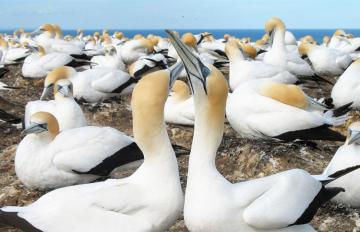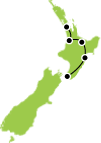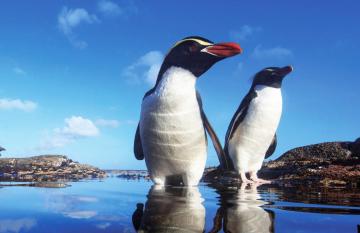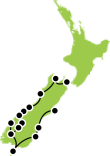
Kea aren’t nicknamed “clowns of the Alps” for nothing. Ths Naughty bird announces itself with a loud piercing cry of ‘Keee-a!’ and is always on the lookout for mischief - and he's looking at you!
WATCH OUT... THERE ARE KEA ABOUT!
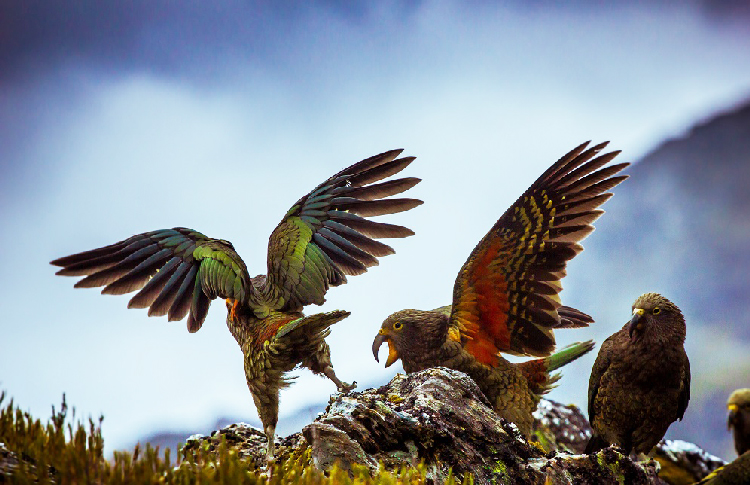
Contents
Smarter than the Average Monkey
The New Zealand Kea, the world's only alpine parrot is known as the 'Clown of the Alps' to South Islanders; and has recently been heralded as the world’s smartest bird (its intelligence rivals a monkey’s) says the Institute of Cognitive Biology in Vienna.
The cheeky Kea, so-called by the call of 'ke-aa' ringing through the air is deeply evocative of New Zealand's Southern Alps. Kea (Nestor notabilis) are parrots and are infamous on our South Island tramping tracks for their insatiable (and deconstructive) inquisitiveness.
David Attenborough narrates this documentary about the Kea, Playful and destructive, it attacks cars, starts landslides and terrorizes New Zealand ski resorts, but behind the bad behaviour there's a sharp mind at work. David tries to play chess with a Kea and discovers how its cheeky character is the key to its survival.
Although kea are not known to “talk” like some other parrots, they’re considered to be as smart as a four-year-old child and have intelligence similar to primates. They are able to solve logic puzzles and enjoy a good challenge. Hunters, farmers and hikers have encountered kea which have figured out how to remove rubbish bin lids and to open sliding doors. One kea even learned that if it carried a piece of firewood to a hiking hut each day and then knocked on the door it would get food in exchange (WOW!).
Some New Zealand's believe this bird should replace the Kiwi as our national symbol (including me)
Click on the Image below to see the BBC - Kea Raid
Map Showing Where you can see Kea
If you would like to see the 'Cheeky Kea' while holiday in New Zealand, just follow the link and answer a few brief questions and we will send you a no obligation, personalised itinerary.
Where do New Zealand's Alpine Parrot Live
Kea live only in the South Island of New Zealand, most commonly in or near alpine areas in forests or scrublands between altitudes of 900 feet (300 metres) and 6,000 feet (2,000 metres). You may find keas' nests among boulders in the forests marked with high altitudes in the alpine environment, although they can sometimes be found in coastal regions. They are often seen at South Island ski-fields and mountain huts.
Where can I see a Kea
Arthur's Pass
Kea are regularly seen within Arthur's Pass village, often at dusk. Scotts Track to Avalanche Peak is a prime site for finding kea in their natural environment, especially around the tree-line. Young kea, identified by a yellow ring around eyes and nostrils, often gather at the viaduct lookout (Deaths Corner) on Highway 73, about 8km west of Arthur's Pass Village.
To get there you can take the TranzAlpine Train or drive from Christchurch.
Homer Tunnel to Milford Sound
The Homer Tunnel on New Zealand's Milford Road is an engineering triumph, and allows access to the stunning Milford Sound. The tunnel is around 100 km (62 mi) from Te Anau, and around 18 km (11 mi) from Milford Sound. From Queenstown, it's around 270 km (167 mi) and from Dunedin, around 390 km (242 mi). As you arrive at Eastern Side of the Tunnel on state Highway 94, there is an area where you can pull over and take photos, and it is here where you are often met by one of New Zealand's native parrots, the cheeky Kea
BE CAREFUL: The Kea delights in eating rubber trim on rental cars! These gregarious birds take great pleasure in "tasting" plastic and rubber pieces of your car, so keep a watch out for them as any damage caused to your rental car may be recouped by the rental company :(
Other Places to see Kea
Visitors often encounter the cheeky birds at South Island ski fields, many huts in Mount Aspiring National Park and on many of the South Island’s great walks.
Read our Blog Carving Up the White Stuff - Skiing New Zealand for a definitive list of New Zealand ski fields.
List of the 'New Zealand Great Walks' to see the Kea or Kaka (forest-dwelling parrot)
Smart but Very Very Naughty
The kea parrot is a lovable pest, unafraid of humans and famous for its curious and playful behaviour. If you ever see keas in the wild you will see them chase each other in the air, then do spirals and loops, and other tricks, both on air and on land. But they are quite naughty too as they are just the right meld of destructive and fearless to really annoy people. Any vehicle parked in the high country is prone to be stripped of rubber, and anything else that isn’t bolted or welded down.
They steal from tourists day and night. They keep mountaineers awake by rolling stones down the metal roof of the high country huts. They chuck rocks at tourists. They break into houses through cat doors. Garbage cans are ransacked. Antennas are chewed off.
Kea are famous for snaffling anything they can get their hooked bill and large, strong claws into. That includes wallets, passports and the odd tourist lunch. They are known to rip holes in tents.
Kea are Threatened and Vulnerable
Kea are unusual in that they actively seek out and interact with people and their property. This ‘neophilia’ – love of new things, has brought people into conflict with kea to an extent that is unprecedented with any other bird species.
Though the Kea does not directly kill sheep, death can result from infections or accidents suffered by animals when trying to escape. This lead to an unfortunate conflict between high country sheep farmers and the kea, resulting in a legal government bounty being initiated in the late 1860s which resulted in an estimated 150,000 kea killed up until the early 1970’s. Fewer than 5,000 individuals remain across an area of 3.5 million hectares and they are now listed as Nationally Threatened and Vulnerable, population decreasing under the IUCN Red List.
Although kea are now fully protected under the Wildlife Act, their investigative behavior often results in the destruction of human property and as a result, they are considered a nuisance in areas where they cross over with people. As such kea deaths due to direct human persecution are recorded each year
Bird of the Year
New Zealander's now love the Kea so much that it was voted Bird of the Year in 2017 - against some very stiff competition. These cheeky creatures socialise on prominent rocky outcrops and windy saddles. These quick learners were in some trouble after targeting farms, but they have received full protection since 1986, and their reputation is improving.
If you see kea…
DO
- Take photos – as long as you’re not holding up traffic or getting too close to the kea
- Make sure your car is closed and locked and the keys safely tucked away
- Close your bag or backpack
- Enjoy seeing these beautiful, intelligent birds in the wild
DON’T
- Feed the kea
- Leave your car open
- Encourage them to come closer or damage property
- Please don't drive off if they are on your car roof as they may fall up and break their fragile bones in their wings - this will inevitably cause death.
Recent Posts
Blog Categories
Blog archives
- April 2025 (2)
- February 2025 (3)
- January 2025 (6)
- December 2024 (12)
- November 2024 (3)
- October 2024 (2)
- July 2024 (2)
- May 2024 (12)
- April 2024 (2)
- March 2024 (2)
- January 2024 (2)
- November 2023 (10)
- October 2023 (4)
- August 2023 (1)
- May 2023 (2)
- April 2023 (2)
- March 2023 (17)
- February 2023 (4)
- January 2023 (4)
- December 2022 (11)
- November 2022 (7)
- October 2022 (1)
- May 2022 (1)
- March 2022 (3)
- February 2022 (3)
- January 2022 (1)
- December 2021 (1)
- August 2021 (1)
- June 2021 (1)
- May 2021 (2)
- February 2021 (1)
- August 2020 (1)
- July 2020 (1)
- May 2020 (1)
- April 2020 (1)
- March 2020 (1)
- January 2020 (1)
- December 2019 (1)
- November 2019 (1)
- October 2019 (1)
- September 2019 (1)
- August 2019 (5)
- July 2019 (2)
- June 2019 (1)
- May 2019 (3)
- April 2019 (1)
- March 2019 (1)
- February 2019 (1)
- January 2019 (1)
- December 2018 (1)
- November 2018 (1)
- September 2018 (1)
- August 2018 (1)
- July 2018 (1)
- June 2018 (1)
- May 2018 (1)
- April 2018 (1)
- March 2018 (1)
- February 2018 (1)
- January 2018 (1)
- December 2017 (1)
- October 2017 (1)
- September 2017 (1)
- August 2017 (1)
- July 2017 (1)
- June 2017 (1)
- May 2017 (1)
- April 2017 (1)
- March 2017 (1)
- February 2017 (1)
- January 2017 (1)
- December 2016 (1)
- November 2016 (1)
- October 2016 (1)
- September 2016 (1)
- August 2016 (1)
- July 2016 (1)
- June 2016 (1)
- May 2016 (1)
- April 2016 (1)
- March 2016 (1)
- February 2016 (1)
- January 2016 (1)
- December 2015 (1)
- November 2015 (1)
- October 2015 (1)
- September 2015 (1)
- August 2015 (1)
- July 2015 (1)
- June 2015 (1)
- May 2015 (1)
- April 2015 (1)
- March 2015 (1)
- February 2015 (1)
- January 2015 (1)
- December 2014 (1)
- November 2014 (1)
- October 2014 (1)
- September 2014 (1)
- July 2014 (1)
- June 2014 (3)
- May 2014 (1)
- April 2014 (1)
- March 2014 (1)
- February 2014 (1)
- January 2014 (1)
- November 2013 (15)
- October 2013 (1)
- September 2013 (1)
- August 2013 (1)
- July 2013 (1)
- May 2013 (1)
- April 2013 (1)
- March 2013 (1)
- February 2013 (1)
- January 2013 (1)
- December 2012 (1)
- November 2012 (2)
- October 2012 (2)
- September 2012 (2)
- August 2012 (2)
- July 2012 (2)
- June 2012 (2)
- May 2012 (2)
- April 2012 (3)
- March 2012 (2)
- February 2012 (2)
- January 2012 (2)
- December 2011 (2)
- November 2011 (1)
- October 2011 (2)
- September 2011 (1)
- August 2011 (1)
- July 2011 (1)
- June 2011 (1)
- May 2011 (1)
- April 2011 (1)
- March 2011 (1)
- February 2011 (1)
- January 2011 (1)
- December 2010 (1)
- November 2010 (1)
- October 2010 (1)
- September 2010 (1)
- August 2010 (1)
- July 2010 (1)
- June 2010 (1)
- May 2010 (1)
- March 2010 (1)
- February 2010 (1)
- January 2010 (1)
- December 2009 (1)
- November 2009 (1)
- October 2009 (1)
- September 2009 (1)
- August 2009 (1)
- July 2009 (1)
- June 2009 (1)
- May 2009 (1)
- April 2009 (1)
- March 2009 (1)
- February 2009 (1)
- January 2009 (1)
- December 2008 (1)
- May 2005 (1)












